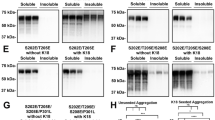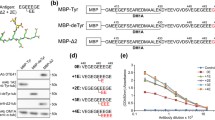Abstract
Cortical neurons are vulnerable to ischemic insult, which may cause cytoskeletal changes and neurodegeneration. Tau is a microtubule-associated protein expressed in neuronal and glial cells. We examined the phosphorylation status of tau protein in the gerbil brain cortex during 5 min ischemia induced by bilateral common carotid artery occlusion followed by reperfusion for 20 min to 7 days. Control brain homogenates contained 63, 65 and 68 kD polypeptides of tau immunoreactive with Alz 50, Tau 14 and Tau 46 antibodies raised against non-phosphorylated tau epitopes. Gerbil tau was also immunoreactive with some (PHF-1 and 12E8) but not all (AT8, AT100, AT180 and AT270) antibodies raised against phosphorylated tau epitopes. PHF-1 recognized a single 68 kD polypeptide and 12E8 bound the 63 kD polypeptide. During 5 min ischemia, PHF-1 immunoreactivity declined to 6%, then recovered to control levels after 20 min of blood recirculation and subsequently increased above control values 3 and 7 days later. In contrast, 12E8 immunoreactivity remained stable during ischemia and reperfusion. Our results suggest that the two phosphorylated epitopes of tau are regulated by different mechanisms and may play different roles in microtubule dynamics. They may also define various pools of neuronal/glial cells vulnerable to ischemia.






Similar content being viewed by others
References
Domanska-Janik K, Lazarewicz J, Noremberg K, Strosznajder J, Zalewska T (1985) Metabolic disturbances of synaptosomes isolated from ischemic gerbil brain. Neurochem Res 10:649–665
Ueda H, Tagawa K, Furuya E, Matsumoto M, Yanagihara T (1999) A combined analysis of regional energy metabolism and immunohistochemical ischemic damage in the gerbil brain. J Neurochem 72:1232–1242
Saito A, Maier CM, Narasimhan P, Nishi T, Song YS, Yu F, Liu J, Lee YS, Nito C, Kamada H, Dodd RL, Hsieh LB, Hassid B, Kim EE, Gonzalez M, Chan PH (2005) Oxidative stress and neuronal death/survival signaling in cerebral ischemia. Mol Neurobiol 31:105–116
Crain BJ, Westerkam WD, Harrison AH, Nadler JV (1988) Selective neuronal death after transient forebrain ischemia in the Mongolian gerbil: a silver impregnation study. Neuroscience 27:387–402
Arai H, Passonneau JV, Lust WD (1986) Energy metabolism in delayed neuronal death of CA1 neurons of the hippocampus following transient ischemia in the gerbil. Metab Brain Dis 1:263–278
Ouyang YB, Tan Y, Comb M, Liu CL, Martone ME, Siesjo B, Hu BR (1999) Survival- and death-promoting events after transient cerebral ischemia: phosphorylation of Akt, release of cytochrome c and activation of caspase-like proteases. J Cereb Blood Flow Metab 19:1126–1135
Mortimer JA, van Duijn CM, Chandra V, Fratiglioni L, Graves AB, Heyman A, Jorm AF, Kokmen E, Kondo K, Rocca WA et al (1991) Head trauma as a risk factor for Alzheimer’s disease: a collaborative re-analysis of case-control studies. EURODEM risk factors research group. Int J Epidemiol 20(Suppl 2):S28–S35
Henon H, Pasquier F, Leys D (2006) Poststroke dementia. Cerebrovasc Dis 22:61–70
Roberts GW (1988). Immunocytochemistry of neurofibrillary tangles in dementia pugilistica and Alzheimer’s disease: evidence for common genesis. Lancet 2:1456–1458
Schmidt ML, Zhukareva V, Newell KL, Lee VM, Trojanowski JQ (2001) Tau isoform profile and phosphorylation state in dementia pugilistica recapitulate Alzheimer’s disease. Acta Neuropathol (Berl) 101:518–524
Geddes JF, Vowles GH, Nicoll JA, Revesz T (1999) Neuronal cytoskeletal changes are an early consequence of repetitive head injury. Acta Neuropathol (Berl) 98:171–178
Hesse C, Rosengren L, Andreasen N, Davidsson P, Vanderstichele H, Vanmechelen E, Blennow K (2001) Transient increase in total tau but not phospho-tau in human cerebrospinal fluid after acute stroke. Neurosci Lett 297:187–190
Goedert M, Jakes R (2005) Mutations causing neurodegenerative tauopathies. Biochim Biophys Acta 1739:240–250
Biernat J, Mandelkow EM (1999) Processes induced by tau protein requires phosphorylation of Serine 262 and 356 in the repeat domain and is inhibited by phosphorylation in the Proline-rich domains. Mol Biol Cell 10:727–740
Ebneth A, Godemann R, Stamer K, Illenberger S, Trinczek B, Mandelkow E (1998) Overexpression of tau protein inhibits kinesin-dependent trafficking of vesicles, mitochondria and endoplasmic reticulum: implications for Alzheimer’s disease. J Cell Biol 143:777–794
Lee G (2005) Tau and src family tyrosine kinases. Biochim Biophys Acta 1739:323–330
Matsuo ES, Shin RW, Billingsley ML, Van deVoorde A, O’Connor M, Trojanowski JQ, Lee VM (1994) Biopsy-derived adult human brain tau is phosphorylated at many of the same sites as Alzheimer’s disease paired helical filament tau. Neuron 13:989–1002
Gartner U, Janke C, Holzer M, Vanmechelen E, Arendt T (1998) Postmortem changes in the phosphorylation state of tau-protein in the rat brain. Neurobiol Aging 19:535–543
Geddes JW, Schwab C, Craddock S, Wilson JL, Pettigrew LC (1994) Alterations in tau immunostaining in the rat hippocampus following transient cerebral ischemia. J Cereb Blood Flow Metab 14:554–564
Shackelford D, Yeh RY (1998) Dephosphorylation of tau during transient forebrain ischemia in the rat. Mol Chem Neuropathol 34:103–120
Mailliot C, Podevin-Dimster V, Rosenthal RE, Sergeant N, Delacourte A, Fiskum G, Buee L (2000) Rapid tau protein dephosphorylation and differential rephosphorylation during cardiac arrest-induced cerebral ischemia and reperfusion. J Cereb Blood Flow Metab 20:543–549
Mayevsky A, Breuer Z (1992) Brain vasculature and mitochondrial responses to ischemia in gerbils. I. Basic anatomical patterns and biochemical correlates. Brain Res 598:242–250
Lazarewicz JW, Salinska E, Spejna E, Gadamski R (1994) Effects of MK-801 and ganglioside GM1 on postischemic prostanoid release and hippocampal lesion in gerbil brain. Acta Neurobiol Exp 54:293–305
Wang Q, Tompkins KD, Simonyi A, Korthuis RJ, Sun AY, Sun GY (2006) Apocynin protects against global cerebral ischemia-reperfusion-induced oxidative stress and injury in the gerbil hippocampus. Brain Res 1090:182–189
Sergeant N, David JP, Lefranc D, Vermersch P, Wattez A, Delacourte A (1997) Different distribution of phosphorylated tau protein isoforms in Alzheimer’s and Pick’s diseases. FEBS Lett 412:578–582
Kalcheva N, Albala JS, Binder LI, Shafit-Zagardo B (1994) Localization of specific epitopes on human microtubule-associated protein 2. J Neurochem 63:2336–2341
Sulkowski G, Struzynska L, Lenkiewicz A, Rafalowska U. (2006) Changes of cytoskeletal proteins in ischaemic brain under cardiac arrest and reperfusion conditions. Folia Neuropathol 44:133–139
Gordon-Krajcer W, Yang L-S, Ksiezak-Reding H (2000) Conformation of paired helical filaments blocks dephosphorylation of epitopes shared with fetal tau except Ser199/202 and Ser202/Thr205. Brain Res 856:163–175
Himmler A, Drechsel D, Kirschner MW, Martin DW Jr (1989) Tau consists of a set of proteins with repeated C-terminal microtubule-binding domains and variable N-terminal domains. Mol Cell Biol 9:1381–1388
Ksiezak-Reding H, Davies P, Yen S-H (1988) Alz 50, a monoclonal antibody to Alzheimer’s disease antigen, cross-reacts with tau proteins from bovine and normal human brain. J Biol Chem 263:7943–7947
Ksiezak-Reding H, Liu W-K, Yen S-H (1992) Phosphate analysis and dephosphorylation of modified tau associated with paired helical filaments. Brain Res 597:209–219
Gartner U, Janke C, Holzer M, Vanmechelen E, Arendt T (1998) Postmortem changes in the phosphorylation state of tau-protein in the rat brain. Neurobiol Aging 19:535–543
Wegiel J, Wisniewski HM, Soltysiak Z (1998) Region and cell-type-specific pattern of tau phosphorylation in dog brain. Brain Res 802:259–266
Reynolds CH, Betts JC, Blackstock WP, Nebreda AR, Anderton BH (2000) Phosphorylation sites on tau identified by nonoelectrospray mass spectrometry: differences in vitro between the mitogen-activated protein kinases ERK2, c-Jun N-terminal kinase and p38, and glycogen synthase kinase-3β. J Neurochem 74:1587–1595
Drewes G, Trinczek B, Illenberger S, Biernat J, Schmitt-Ulms G, Meyer HE, Mandelkow EM, Mandelkow E (1995) Microtubule-associated protein/microtubule affinity-regulating kinase (p110mark). A novel protein kinase that regulates tau-microtubule interactions and dynamic instability by phosphorylation at the Alzheimer-specific site serine 262. J Biol Chem 270:7679–7688
Litersky JM, Johnson GV, Jakes R, Goedert M, Lee M, Seubert P (1996) Tau protein is phosphorylated by cyclic AMP-dependent protein kinase and calcium/calmodulin-dependent protein kinase II within its microtubule-binding domains at Ser-262 and Ser-356. Biochem J 316(Pt 2):655–660
Biernat J, Gustke N, Drewes G, Mandelkow EM, Mandelkow E (1993) Phosphorylation of Ser262 strongly reduces binding of tau to microtubules: distinction between PHF-like immunoreactivity and microtubule binding. Neuron 11:153–163
Dewar D, Dawson D (1995) Tau protein is altered by focal cerebral ischemia in the rat: an immunohistochemical and immunoblotting study. Brain Res 684:70–78
Wen Y, Yang S, Liu R, Simpkins JW (2004) Transient cerebral ischemia induces site-specific hyperphosphorylation of tau protein. Brain Res 1022:30–38
Pettigrew LC, Holtz ML, Craddock SD, Minger SL, Hall N, Geddes JW (1996) Microtubular proteolysis in focal cerebral ischemia. J Cereb Blood Flow Metab 16:1189–1202
Zalewska T, Zablocka B, Domanska-Janik K (1996) Changes of Ca2+/calmodulin-dependent protein kinase-II after transient ischemia in gerbil hippocampus. Acta Neurobiol Exp 56:41–48
Zablocka B, Meternicka K, Zalewska T, Domanska-Janik K (1998) Expression of Ca 2+-dependent (classical) PKC mRNA isophorms after transient cerebral ischemia in gerbil hippocampus. Brain Res 779:254–258
Tanaka K, Ito D, Suzuki S, Dembo T, Kosakai A, Fukuuchi Y (2002) A novel voltage-sensitive Na(+) and Ca(2+) channel blocker, NS-7, prevents suppression of cyclic AMP-dependent protein kinase and reduces infarct area in the acute phase of cerebral ischemia in rat. Brain Res 924:98–108
Endo H, Nito C, Kamada H, Nishi T, Chan PH (2006) Activation of the Akt/GSK3beta signaling pathway mediates survival of vulnerable hippocampal neurons after transient global cerebral ischemia in rats. J Cereb Blood Flow Metab Mar 15 [Epub ahead of print]
Sontag E, Nunbhakdi-Craig V, Lee G, Bloom GS, Mumby MC (1996) Regulation of the phosphorylation state and microtubule-binding activity of Tau by protein phosphatase 2A. Neuron 17:1201–1207
Liu F, Grundke-Iqbal I, Iqbal K, Gong CX (2005) Contributions of protein phosphatases PP1, PP2A, PP2B and PP5 to the regulation of tau phosphorylation. Eur J Neurosci 22:1942–1950
Morioka M, Fukunaga K, Hasegawa S, Okamura A, Korematsu K, Kai Y, Hamada J, Nagahiro S, Miyamoto E, Ushio Y (1999) Activities of calcineurin and phosphatase 2A in the hippocampus after transient forebrain ischemia. Brain Res 828:135–144
Hashimoto T, Kawamata T, Saito N, Sasaki M, Nakai M, Niu S, Taniguchi T, Terashima A, Yasuda M, Maeda K, Tanaka C (1998) Isoform-specific redistribution of calcineurin A alpha and A beta in the hippocampal CA1 region of gerbils after transient ischemia. J Neurochem 70:1289–1298
Irving EA, Barone FC, Reith AD, Hadingham SJ, Parsons AA (2000) Differential activation of MAPK/ERK and p38/SAPK in neurons and glia following focal cerebral ischaemia in the rat. Mol Brain Res 77:65–75
Erdo F, Trapp T, Mies G, Hossmann KA (2004) Immunohistochemical analysis of protein expression after middle cerebral artery occlusion in mice. Acta Neuropathol (Berl) 107:127–136
Davis DR, Anderton BH, Brion JP, Reynolds CH, Hanger DP (1997) Oxidative stress induces dephosphorylation of tau in rat brain primary neuronal cultures. J Neurochem 68:1590–1597
Gomez-Ramos A, Diaz-Nido J, Smith MA, Perry G, Avila J (2003) Effect of the lipid peroxidation product acrolein on tau phosphorylation in neural cells. J Neurosci Res 71:863–870
Acknowledgments
The authors express special thanks to Drs. Peter Davies and Bridget Shafit-Zagardo (Albert Einstein College of Medicine, Bronx, NY), Peter Seubert (Athena Neurosciences, Inc. and Elan Pharmaceuticals, Inc., CA), David Martin (Genentech Inc, San Francisco, CA), André Delacourte and Luc Buée (INSERM U422, Lille Cedex, France), Lester Binder (Northwestern University, IL) and A. Van de Voorde and E. Vanmechelen of Innogenetics, N.V. (Ghent, Belgium) for generous gifts of antibodies. The authors gratefully acknowledge an expert technical assistance of Mrs. Apolonia Ziembowicz.
Author information
Authors and Affiliations
Corresponding author
Additional information
Special issue dedicated to John P. Blass.
Rights and permissions
About this article
Cite this article
Gordon-Krajcer, W., Kozniewska, E., Lazarewicz, J.W. et al. Differential Changes in Phosphorylation of Tau at PHF-1 and 12E8 Epitopes During Brain Ischemia and Reperfusion in Gerbils. Neurochem Res 32, 729–737 (2007). https://doi.org/10.1007/s11064-006-9199-3
Received:
Accepted:
Published:
Issue Date:
DOI: https://doi.org/10.1007/s11064-006-9199-3




